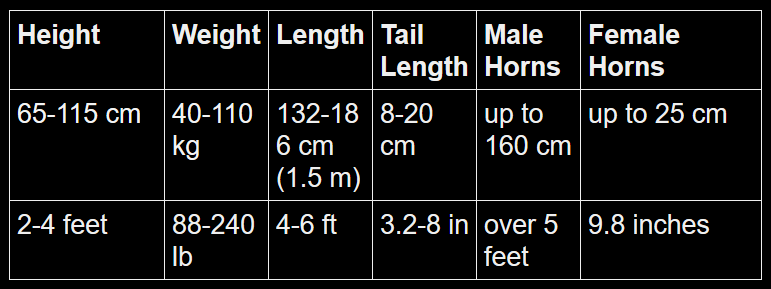About The Markhor
The Markhor belongs to a group of animals called ‘goat-antelopes’ and is the largest species in the goat family and it occupies the mountains of central Asia. It is the national animal of Pakistan. Currently, the Markhor is classified as near threatened according to the IUCN red list, and is on Earth’s endangered species list. However, some types of markhor are more threatened than others. For example, on the fish and wildlife service species list, the Straight-horned markhor (Capra falconeri megaceros) is listed as threatened and the Chiltan markhor (Capra falconeri chiltanensis) is listed as endangered.
Markhors are known for their horns. They are often called the screw-horned goat due to their corkscrew-shaped horns that can grow to be quite large on males (over 5 feet). Depending on the subspecies, their horns may be straight or be almost like a curve that is flared outward. There is not a huge difference in the appearance of male and female markhors other than males having a lighter tan color, longer horns and longer beards on their chins. Both are tan with white underparts as well as black and white patterns on their legs. Their faces are black colored and they have long white fur on their necks and chests that can become very long.
Markhor Physical Statistics

Why is the Markhor Threatened?
The markhor is mainly threatened due to the desire for its beautiful horns, which are highly sought after by trophy hunters. Even with the goat being Pakistan’s national animal, it is still legally allowed to be hunted there. While these horns are wanted solely for display purposes, many who live in areas where markhors are common, want to hunt them as a food source, some even want to hunt them for medicinal purposes. The markhor also faces challenges over living space because their areas are often taken over for domestic livestock. There are 5 subspecies of markhor, and some are more endangered than others.
This is upsetting due to the markhors’ importance in its own ecosystem. Markhors, being herbivores and grazers, carry seeds for many of the plants in their ecosystem through their fecal waste. Markhors act as the primary consumer in their ecosystems. The markhor is also very important in the Asian medicine business as their horns are a core ingredient in many of Asia’s traditional medicines and have sold for up to 1,000 USD per kilogram in China.
However, there are efforts being made to save the markhor. Markhor numbers have increased over the past several years, this is show by how the status of the goat has gone from endangered down to around threatened or near threatened. The numbers have climbed from 40-50 in the 1990s to somewhere above 3,500 currently. Efforts being made to protect the markhor include the five parks that have set up sanctuaries for the goat. Expensive permits have been handed out for hunting the Markhor and high fines have been issued for those without a permit, this effort has helped the markhor number increase drastically. The hunting of the goat has also been limited to the older goats who have already reproduced and often has difficulty moving due to the weight of its horn. The wildlife conservation organization “Save Our Species” has have been informing communities in Pakistan, where the animal is culturally appreciated, about conservation efforts and how to save the species.
Sources
“9 Things You Didn’t Know about Markhor.” Youth Impact. N.p., n.d. Web. 19 Feb. 2017
“Markhor Goat.” Animal Corner. N.p., n.d. Web. 15 Feb. 2017.
“Capra Falconeri .” IUCN Red List. N.p., n.d. Web. 15 Feb. 2017.